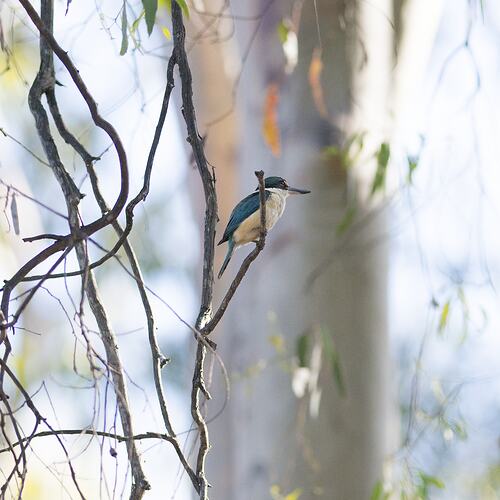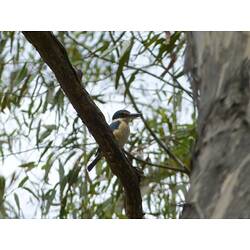General Description
Back, rump and tail turquoise, underparts yellow-brown and neck white. Head blue-green with wide black stripe extending from bill through eye to back of the neck. Upper bill black, lower bill cream. Females typically lighter with duller wing colouring. Body is up to 24 cm.
Biology
Sacred Kingfishers are solitary except for in the breeding season (September - March) when they form pairs. Their nest is an inclined burrow in a tree hollow, termite mound or river bank. Both sexes build the nest and the nest chamber is generally unlined. Nests can be re-used over consecutive seasons. Two clutches of three to four eggs are laid per season, with both sexes incubating and caring for the chicks. They mainly forage on land but can also catch prey in water, eating insects, crustaceans, reptiles and small vertebrates. They catch their prey by swooping down from a nearby branch, and then they return to the perch to eat. In Australia, Sacred Kingfishers breed in the south of their range, returning north in winter.
Distribution
New Zealand, Indonesia and New Guinea. Mainland Australia and Tasmania and offshore islands.
Habitat
Open dry woodlands and forests, mangroves, along rivers and lakes, and occasionally in urban parks.
More Information
-
Animal Type
-
Animal SubType
-
Brief Id
A medium-sized kingfisher with a black stripe through the eye and a white neck collar.
-
Colours
Blue, Yellow, White
-
Maximum Size
24 cm
-
Habitats
-
Diet
Carnivore
-
Diet Categories
Fish, Crustaceans, Invertebrates
-
Endemicity
-
Commercial
No
-
Conservation Statuses
CITES: Not listed, FFG Threatened List: Not listed, EPBC Act 1999: Not listed, IUCN Red List: Least Concern
-
Taxon Name
-
Common Name
Sacred Kingfisher
-
Kingdom
-
Phylum
-
Subphylum
-
Class
-
Order
-
Family
-
Genus
-
Species Name
sanctus





